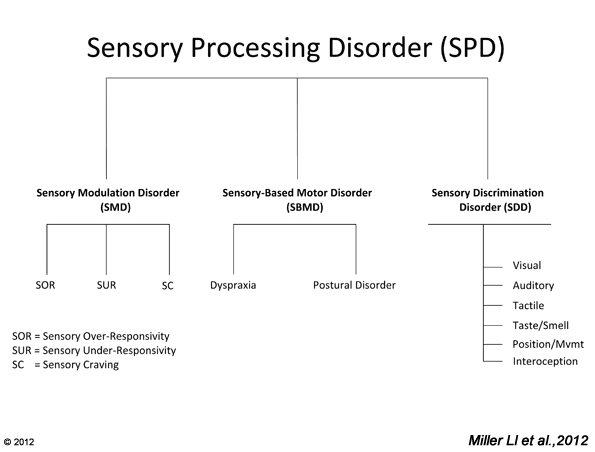Understanding sensory processing disorder can be difficult in large part due to the fact that there is not currently a medical diagnostic description for it. Other disorders like autism, ADD, or specific learning disorders have this kind of outline, and are known well to health professionals and parents alike.
While Jean Ayres, PhD, OTR defined sensory integration and sensory integration dysfunction in the 1970’s, there has been on-going research and diverging theories that actually make it even harder for us to talk about SPD as a condition. One could argue semantics over a philosophical debate, but when discussing a medical condition, it’s most helpful to have a common language. It ensures we’re all on the same page.
To that end, Dr. Lucy Miller has proposed using the term “Sensory Processing Disorder” as an umbrella term that includes six sub-types of the disorder. The below graphic is a little dense, but it gives you an idea of the umbrella and everything that’s underneath it.

In upcoming blog posts, I’ll explore each sub-type more in depth. But to start, here are some key points that are helpful in understanding SPD:
- SPD is not one condition but rather a collection of conditions that are each unique in terms of symptoms.
- SPD includes disorders of the 8 sensory systems:
- Visual
- Auditory
- Tactile (touch)
- Gustatory (taste)
- Olfactory (smell)
- Vestibular (movement)
- Proprioception (body awareness, position)
- Interoception (internal organs)
- Dyspraxia and Postural Disorder – motor-based disorders – are most closely associated with problems in processing vestibular (movement) and proprioceptive (body awareness) input.
- Modulation disorders (when it’s hard for someone to regulate their level of alertness) can affect any of the 8 sensory systems and often appear in combination.
- For example, a person might be SOR (sensory over-responsive) in auditory, SUR (sensory under-responsive) in tactile, and sensory craving in vestibular/movement.
- Sensory discrimination disorders are the inability to perceive subtle differences in sensory information. That leads to poor interpretation or perception of information, and these disorders can affect any of the 8 systems.
- An individual can have any of the 8 systems affected by sensory processing issues. This creates a huge list of potential combinations of SPD sub-types – millions of possible combinations when you do the math!
- In order to determine what approach, strategies, and accommodations will help with reducing the impact of the disorder, in-depth examination and understanding of an individual is essential.
Hopefully, that’s a good start on the basics of SPD, and what’s meant by sub-types and various disorders with in the condition. Next up: We’ll look at each sub-type individually and explore the various associated behaviors you might encounter in children struggling with them.
And don’t forget: if you’re local, join us at our Introduction to SPD with Q&A events on October 26 and 30. Learn more here, and contact us for more information about SPD or to discuss your child’s needs.
